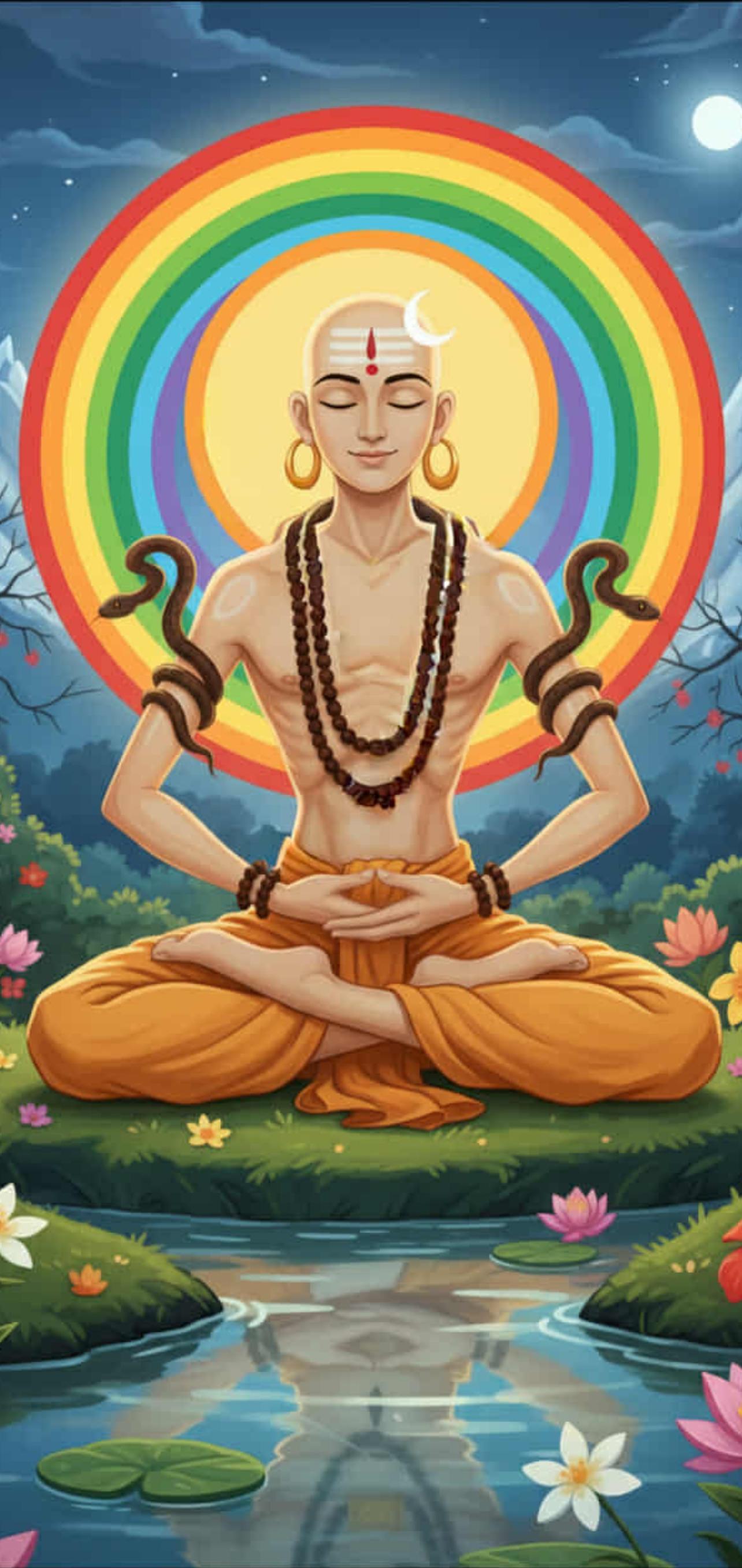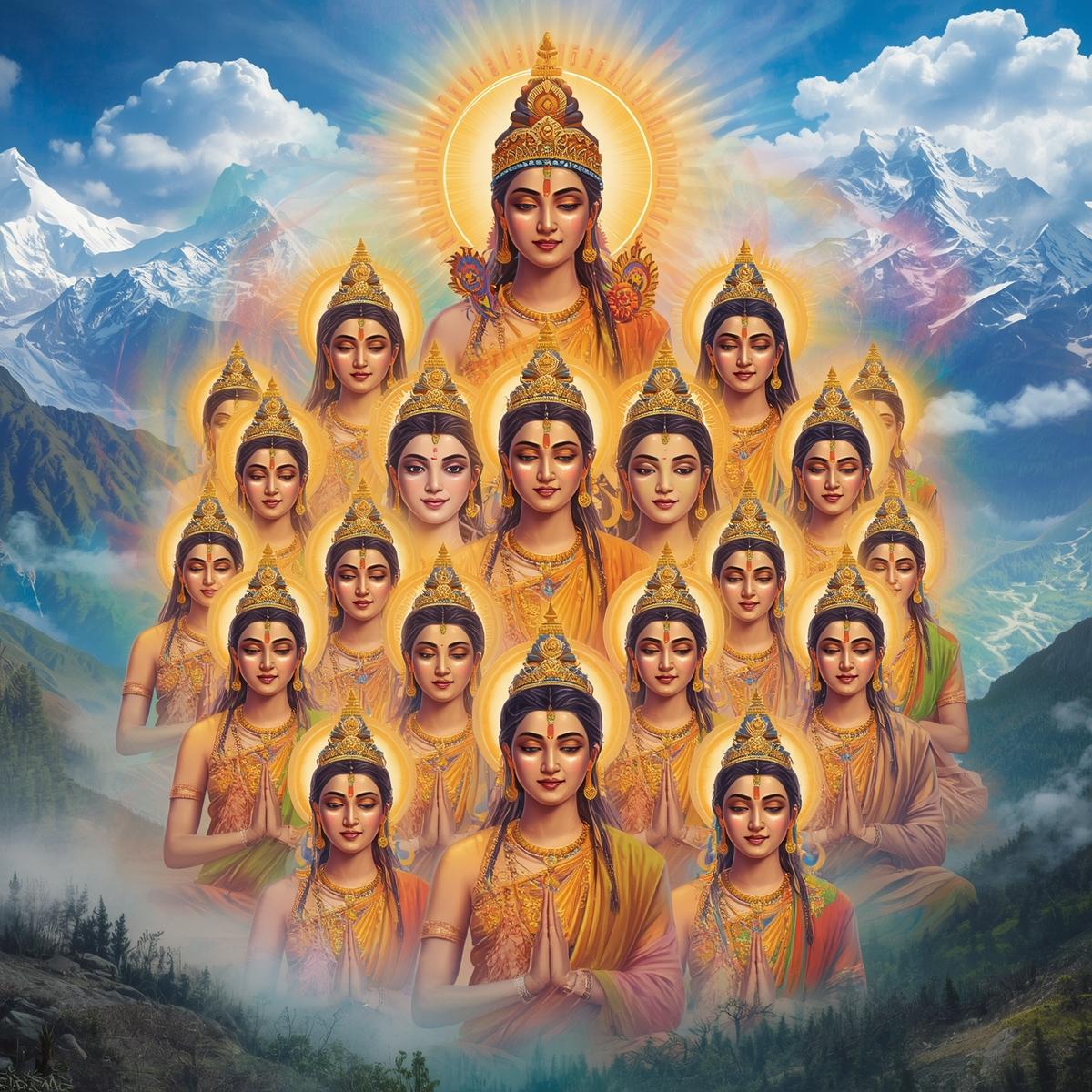आध्यात्मिक दीपावली — सिद्धों के अंतःप्रकाश की अनुभूति
एक योगी के लिए, एक साधक के लिए, सच्ची दीपमाला अथवा वास्तविक दीपावली वह नहीं है जो बाहर दीपों से जगमगाती है,
बल्कि वह है जो अंतःकरण में, चेतना के गहनतम स्तरों पर, भीतर के प्रकाश को जागृत करती है।
जब साधक अपनी साधना में निरंतर स्थिर होता है,
तो धीरे-धीरे उसकी सुषुम्ना नाड़ी में ऊर्जा का प्रवाह आरंभ होता है,
और यह प्रवाह उसे सहस्रार कमल तक पहुँचा देता है —
जहाँ एक हजार पंखुड़ियों वाला दिव्य कमल खिलता है।
हमारा मस्तिष्क उसी सहस्रार का स्थूल प्रतिबिंब है —
इसमें सूक्ष्म रूप से एक हजार बिंदु या पर्ण विद्यमान हैं,
जिन्हें योगशास्त्र में “दीये समान बिंदु” कहा गया है।
जब साधक गहन ध्यान और जागरूकता के माध्यम से इन सभी बिंदुओं को
प्रकाशित कर देता है, तब उसका सम्पूर्ण चैतन्य उज्ज्वल हो उठता है —
वही क्षण होता है उसकी असली दीपावली,
जहाँ हर पर्ण एक दीपक बनकर भीतर के अंधकार को आलोकित करता है।
सिद्धों के अनुभव में यह कहा गया है कि जब वे गहन ध्यानावस्था में प्रवेश करते हैं,
और सुषुम्ना मार्ग से क्रमशः ऊपर उठते हुए ब्रह्मरंध्र (सहस्रार द्वार) तक पहुँचते हैं,
तो वहाँ एक अलौकिक ज्योति, एक अनंत प्रकाश का सागर अनुभव होता है।
उस अवस्था में उन्हें सम्पूर्ण ब्रह्मांड का दृश्य एक बिंदु में सिमटा हुआ प्रतीत होता है —
सृष्टि की प्रत्येक ज्योति, प्रत्येक नक्षत्र, प्रत्येक तारा,
जैसे किसी दिव्य दीपमाला के रूप में प्रकाशित हो रहा हो।
वह अनुभव ही योगी की अंतर्यात्रा की दीपावली है —
जहाँ भीतर का दीपक, ब्रह्मांड के दीपों से एकाकार हो जाता है।
जिस प्रकार हमारे जीवन में दीपावली का उत्सव आती है —
अंधकार पर प्रकाश की विजय के रूप में,
उसी प्रकार यह ब्रह्मांडीय दीपावली निरंतर घटित हो रही है।
यदि हम सूक्ष्म दृष्टि से देखें, तो यह सम्पूर्ण ब्रह्मांड
अनगिनत दीपों से आलोकित है —
नक्षत्र, ग्रह, तारामंडल निरंतर जलते और बुझते रहते हैं।
यह दृश्य ऐसे प्रतीत होता है मानो सम्पूर्ण ब्रह्मांड स्वयं दीपावली मना रहा हो।
यही अनुभूति सिद्धों के अपने निज ब्रह्मांड — सहस्रार कमल दल में होती है।
वहाँ वे देखते हैं कि भीतर का प्रकाश और बाहरी ब्रह्मांड का प्रकाश एक ही है।
वहां “मैं” और “ब्रह्मांड” का भेद समाप्त हो जाता है —
केवल ज्योति ही शेष रह जाती है, और वही परम दीपमाला है।
ऋषि-मुनियों ने इसी दिव्य अनुभूति को प्रतीकात्मक रूप में दीपावली उत्सव के रूप में मानव समाज को प्रदान किया —
ताकि प्रत्येक मनुष्य बाहरी दीपों के माध्यम से अपने भीतर के दीप को जगाने की प्रेरणा पाए।
जब भीतर का दीप जल उठे,
तभी बाहरी दीपावली सार्थक होती है।
और वही है —
सिद्धों के असली दीपावली।
ॐ सम सिद्धाय नमः
ॐ श्री पद्मप्रिया सुरम्या रमापति ईशपुत्राय नमः
#Ishaputra #KaulantakPeeth #MahaHimalaya #Yogini #Sadhana #siddhi #yoga #MahasiddhaIshaputra #MahayogiSatyendranath #mystic #Meditation #Kulantpeeth #HappyDivali2025 #Divali2025 #dipavali2025
🌺 आध्यात्मिक दीपावली — सिद्धों के अंतःप्रकाश की अनुभूति 🎆
एक योगी के लिए, एक साधक के लिए, सच्ची दीपमाला अथवा वास्तविक दीपावली वह नहीं है जो बाहर दीपों से जगमगाती है,
बल्कि वह है जो अंतःकरण में, चेतना के गहनतम स्तरों पर, भीतर के प्रकाश को जागृत करती है।
जब साधक अपनी साधना में निरंतर स्थिर होता है,
तो धीरे-धीरे उसकी सुषुम्ना नाड़ी में ऊर्जा का प्रवाह आरंभ होता है,
और यह प्रवाह उसे सहस्रार कमल तक पहुँचा देता है —
जहाँ एक हजार पंखुड़ियों वाला दिव्य कमल खिलता है।
हमारा मस्तिष्क उसी सहस्रार का स्थूल प्रतिबिंब है —
इसमें सूक्ष्म रूप से एक हजार बिंदु या पर्ण विद्यमान हैं,
जिन्हें योगशास्त्र में “दीये समान बिंदु” कहा गया है।
जब साधक गहन ध्यान और जागरूकता के माध्यम से इन सभी बिंदुओं को
प्रकाशित कर देता है, तब उसका सम्पूर्ण चैतन्य उज्ज्वल हो उठता है —
वही क्षण होता है उसकी असली दीपावली,
जहाँ हर पर्ण एक दीपक बनकर भीतर के अंधकार को आलोकित करता है।
सिद्धों के अनुभव में यह कहा गया है कि जब वे गहन ध्यानावस्था में प्रवेश करते हैं,
और सुषुम्ना मार्ग से क्रमशः ऊपर उठते हुए ब्रह्मरंध्र (सहस्रार द्वार) तक पहुँचते हैं,
तो वहाँ एक अलौकिक ज्योति, एक अनंत प्रकाश का सागर अनुभव होता है।
उस अवस्था में उन्हें सम्पूर्ण ब्रह्मांड का दृश्य एक बिंदु में सिमटा हुआ प्रतीत होता है —
सृष्टि की प्रत्येक ज्योति, प्रत्येक नक्षत्र, प्रत्येक तारा,
जैसे किसी दिव्य दीपमाला के रूप में प्रकाशित हो रहा हो।
वह अनुभव ही योगी की अंतर्यात्रा की दीपावली है —
जहाँ भीतर का दीपक, ब्रह्मांड के दीपों से एकाकार हो जाता है।
जिस प्रकार हमारे जीवन में दीपावली का उत्सव आती है —
अंधकार पर प्रकाश की विजय के रूप में,
उसी प्रकार यह ब्रह्मांडीय दीपावली निरंतर घटित हो रही है।
यदि हम सूक्ष्म दृष्टि से देखें, तो यह सम्पूर्ण ब्रह्मांड
अनगिनत दीपों से आलोकित है —
नक्षत्र, ग्रह, तारामंडल निरंतर जलते और बुझते रहते हैं।
यह दृश्य ऐसे प्रतीत होता है मानो सम्पूर्ण ब्रह्मांड स्वयं दीपावली मना रहा हो।
यही अनुभूति सिद्धों के अपने निज ब्रह्मांड — सहस्रार कमल दल में होती है।
वहाँ वे देखते हैं कि भीतर का प्रकाश और बाहरी ब्रह्मांड का प्रकाश एक ही है।
वहां “मैं” और “ब्रह्मांड” का भेद समाप्त हो जाता है —
केवल ज्योति ही शेष रह जाती है, और वही परम दीपमाला है।
ऋषि-मुनियों ने इसी दिव्य अनुभूति को प्रतीकात्मक रूप में दीपावली उत्सव के रूप में मानव समाज को प्रदान किया —
ताकि प्रत्येक मनुष्य बाहरी दीपों के माध्यम से अपने भीतर के दीप को जगाने की प्रेरणा पाए।
जब भीतर का दीप जल उठे,
तभी बाहरी दीपावली सार्थक होती है।
और वही है —
सिद्धों के असली दीपावली।
ॐ सम सिद्धाय नमः 🙏
ॐ श्री पद्मप्रिया सुरम्या रमापति ईशपुत्राय नमः 🙏
#Ishaputra #KaulantakPeeth #MahaHimalaya #Yogini #Sadhana #siddhi #yoga #MahasiddhaIshaputra #MahayogiSatyendranath #mystic #Meditation #Kulantpeeth #HappyDivali2025 #Divali2025 #dipavali2025










